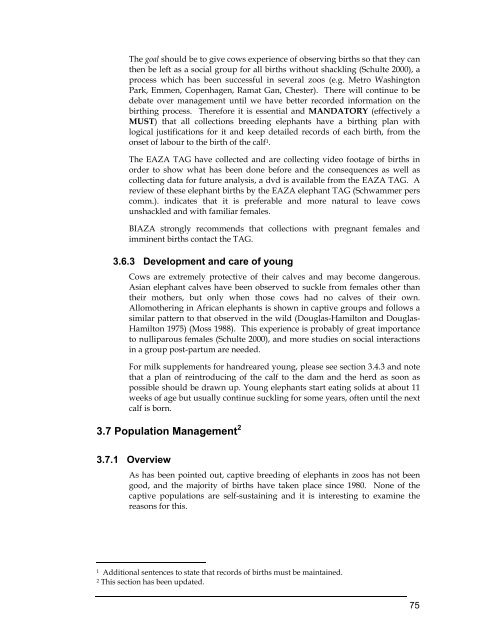Elephants Elephants - Wildpro - Twycross Zoo
Elephants Elephants - Wildpro - Twycross Zoo
Elephants Elephants - Wildpro - Twycross Zoo
Create successful ePaper yourself
Turn your PDF publications into a flip-book with our unique Google optimized e-Paper software.
The goal should be to give cows experience of observing births so that they can<br />
then be left as a social group for all births without shackling (Schulte 2000), a<br />
process which has been successful in several zoos (e.g. Metro Washington<br />
Park, Emmen, Copenhagen, Ramat Gan, Chester). There will continue to be<br />
debate over management until we have better recorded information on the<br />
birthing process. Therefore it is essential and MANDATORY (effectively a<br />
MUST) that all collections breeding elephants have a birthing plan with<br />
logical justifications for it and keep detailed records of each birth, from the<br />
onset of labour to the birth of the calf 1.<br />
The EAZA TAG have collected and are collecting video footage of births in<br />
order to show what has been done before and the consequences as well as<br />
collecting data for future analysis, a dvd is available from the EAZA TAG. A<br />
review of these elephant births by the EAZA elephant TAG (Schwammer pers<br />
comm.). indicates that it is preferable and more natural to leave cows<br />
unshackled and with familiar females.<br />
BIAZA strongly recommends that collections with pregnant females and<br />
imminent births contact the TAG.<br />
3.6.3 Development and care of young<br />
Cows are extremely protective of their calves and may become dangerous.<br />
Asian elephant calves have been observed to suckle from females other than<br />
their mothers, but only when those cows had no calves of their own.<br />
Allomothering in African elephants is shown in captive groups and follows a<br />
similar pattern to that observed in the wild (Douglas-Hamilton and Douglas-<br />
Hamilton 1975) (Moss 1988). This experience is probably of great importance<br />
to nulliparous females (Schulte 2000), and more studies on social interactions<br />
in a group post-partum are needed.<br />
For milk supplements for handreared young, please see section 3.4.3 and note<br />
that a plan of reintroducing of the calf to the dam and the herd as soon as<br />
possible should be drawn up. Young elephants start eating solids at about 11<br />
weeks of age but usually continue suckling for some years, often until the next<br />
calf is born.<br />
3.7 Population Management 2<br />
3.7.1 Overview<br />
As has been pointed out, captive breeding of elephants in zoos has not been<br />
good, and the majority of births have taken place since 1980. None of the<br />
captive populations are self-sustaining and it is interesting to examine the<br />
reasons for this.<br />
1 Additional sentences to state that records of births must be maintained.<br />
2 This section has been updated.<br />
75

















